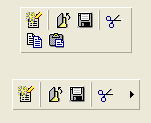Using IlvAbstractBar
IlvAbstractBar is an abstract class for managing the size and position of menu bar or toolbar items. See Using IlvAbstractMenu and Using IlvMenuItem.
This section covers these topics:
Setting the Bar Orientation
You can specify the orientation of the bar with the member function setOrientation and retrieve it with getOrientation.
The bar can be vertical, in which case menu items are arranged from top to bottom, or it can be horizontal, in which case items are arranged from left to right.

Vertical and Horizontal Toolbars
Constraining the Bar Geometry
You can constrain the bar geometry so that all its items are visible whatever its size with the member function setConstraintMode. When this member function is set to IlTrue, the bar is automatically resized to accommodate all its items. Items can be extended to several lines if necessary. To know whether the constraint mode is on, call useConstraintMode.

Constrained (Top) and Nonconstrained Toolbars (Bottom)
Notifying the Bar About Geometry Changes
When the constraint mode is on, the virtual member function geometryChanged is called if:
Setting the Default Item Size
You can set a default size for all the items in a bar with the member function setDefaultItemSize and retrieve it with getDefaultItemSize. You can specify the spacing between two items in a bar with setSpacing and retrieve it with getSpacing.
Aligning Items Flush-right
You can align the last item in a bar with its right border with the member function setFlushingRight. Help menus, for example, are flush-right most of the time.

Help Menu Aligned Flush-right
Using Docking Features
You can dock and undock abstract bar objects. See Using Docking Bars.
Published date: 05/24/2022
Last modified date: 02/24/2022





